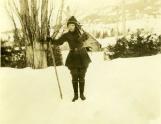14
By 1921, Revelstoke was truly on the map concerning ski jumping and winter carnival tournaments. It was a world class destination and its moniker was "Capital of Canada's Alps." The tournament in 1921 cost $5800 (up from $200 in 1915) and at this tournament 4 jumping records were broken. 3000 spectators would throng to the Big Hill to see some of the best jumpers in the world compete. The CPR would bring sleeping cars into town, parked along the tracks, for spectators to bunk in, since all the hotels and motels in town were full.15
Revelstoke Ski Tournament1921
Revelstoke, British Columbia
 Credits:
Credits:Revelstoke Museum and Archives
16
Nels' brother, Ivind, was a beautiful jumper. Where Nels was known for his distance, Ivind was known for his form. He was likened to a bird in flight. Ivind won many of the boys' competitions and set world records alongside his brother, Nels. He became World's Boy Champion in 1922.17
Ivind Nilsen ski jumpingc. 1920 (?)
Revelstoke, British Columbia
 Credits:
Credits:Revelstoke Museum and Archives
18
In 1922, at the age of 16, Isabel Coursier debuted on the Big Hill, jumping with the boys for a distance of 84 feet and setting a world record. Women typically did not jump, or if they did, they jumped "tandem," assisted by a male jumper. Isabel's technique was described as "fearless and graceful like some well-poised bird." In 1923, Coursier was presented with a Gold Medal by the Revelstoke Ski Club "in appreciation of the skill and daring displayed by the only lady ski jumper in America." She was the only woman to compete unassisted that year (1923).19
Isabel Coursier on the famous ski hill in Revelstoke1922
Revelstoke, British Columbia
 Credits:
Credits:Revelstoke Museum and Archives
20
Born in Revelstoke in 1906, Isabel Coursier had an adventurous spirit and in her words "I was always in the out-of-doors sliding on something either by the seat of my pants or a pan or a shovel or a piece of linoleum." She got her first skis at age 8 (single groove) made by local trapper, Bob Blackmore and later on bought jumping skis (double groove) from local merchant, F.B. Wells. As to what to wear, she advised anything that was comfortable: riding britches, bloomers or men's pants and any comfortable, lace-up boot. She also cross-country raced on her jumping skis, though their heaviness precluded her from placing, and she ski-jored as well.Coursier was studying at McGill University and returned to Revelstoke in February 1928, where at the request of many, jumped 103' on the Class "B" jump with no previous practice or training for 5 years. She was admired greatly for her determination and athletic prowess.
22
In 1923, Nelsen broke yet another record with his jump of 202' in a blinding snowstorm. The Revelstoke Review of Feb. 5, 1923 reported, "The one and only Nels Nelsen demonstrated, in the words of one of the eastern jumpers, that he is in a class by himself in the ski sort, by going to the extreme top of the new trestle on the world's biggest hill, and in the face of a heavy snowfall, which practically blinded all jumpers, made a beautiful jump of 202 feet."23
Nels Nelsen, Ski Champion1923
Revelstoke, British Columbia
 Credits:
Credits:Revelstoke Museum and Archives
24
In 1923, the Winter Carnival tournament was at its peak of popularity having 99 jumpers competing and 64 competitors in the long distance races. There were many other events at the tournament as well: the pony ski race, dog ski race, war baby race, potato ski race, ski descent race and boys" and girls" running races. Prizes were always given in all categories and social events held during the tournament evenings.25
Women's cross country ski race, Winter Tournament1921
Revelstoke, British Columbia
 Credits:
Credits:Revelstoke Museum and Archives
26
1925 was the high point of Nels Nelsen's career when he jumped 240' for a World Record. This record stood until 1931. Interestingly, Nels was jumping "under the weather" as he had a case of the flu! In 1928, Nels had plans to go to the winter Olympics in Europe though he didn't have the money to travel. He had a plan to work his way across the Atlantic on a steamer; however when the Olympic officials heard this they denied Nelsen, saying that this was no fit way for an athlete of his caliber to travel. Unfortunately, Nelsen had to stay home. He worked for the Canadian Pacific Railway as a brakeman, and in this position, had a certain amount of flexibility to travel to tournaments and competitions. In 1932, Nels shot his hand off in a hunting accident which ended his jumping career. However, he was still able and willing to coach, instruct, organize events and promote the sport.27
Nels Nelsen, World Champion jumping 240'1925
Revelstoke, British Columbia
 Credits:
Credits:Revelstoke Museum and Archives
